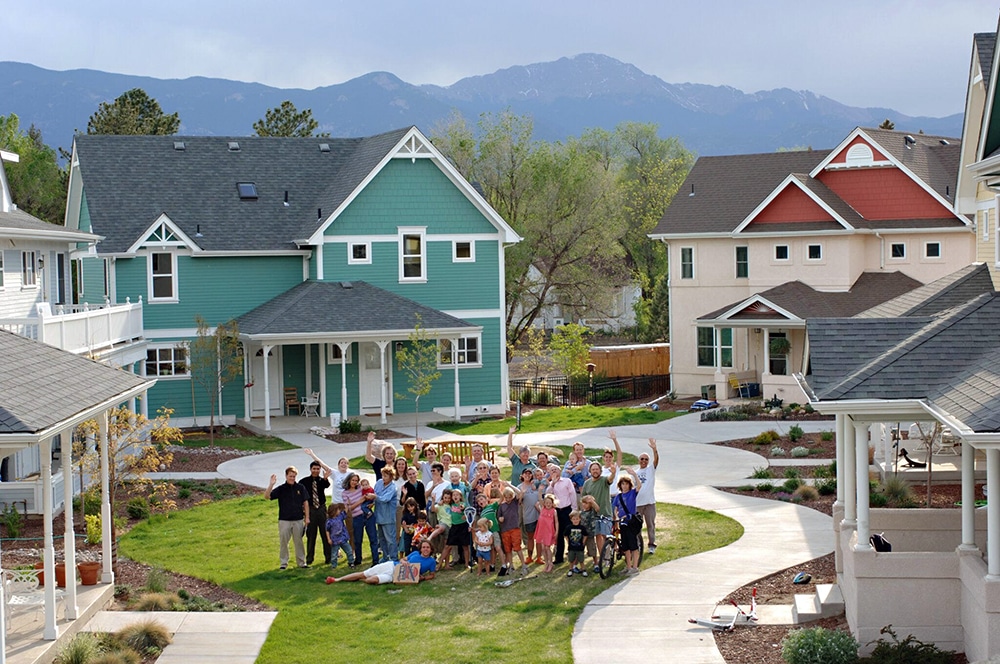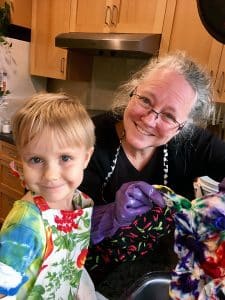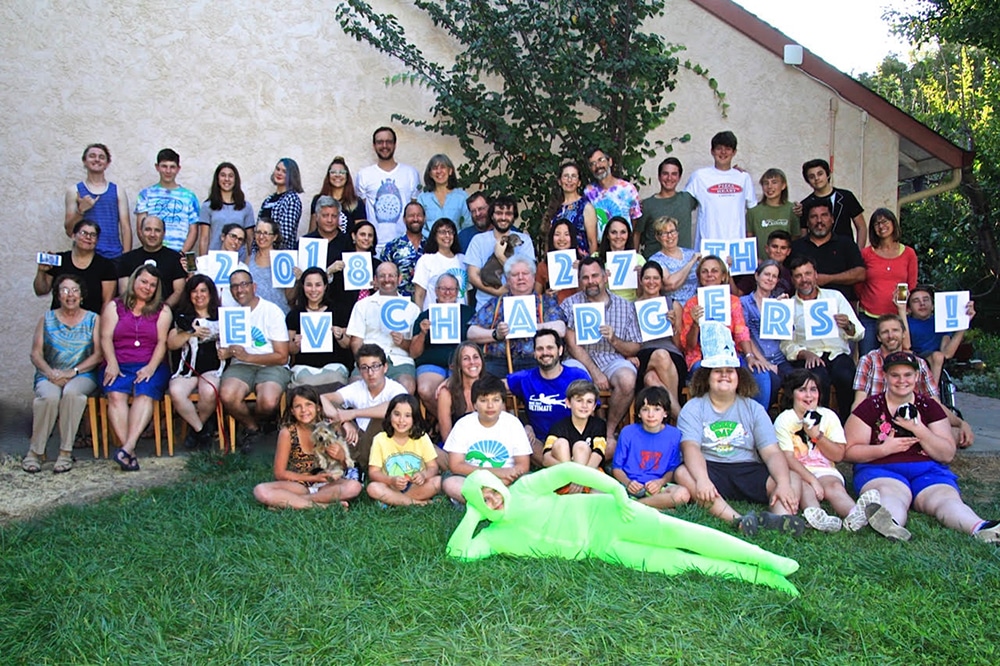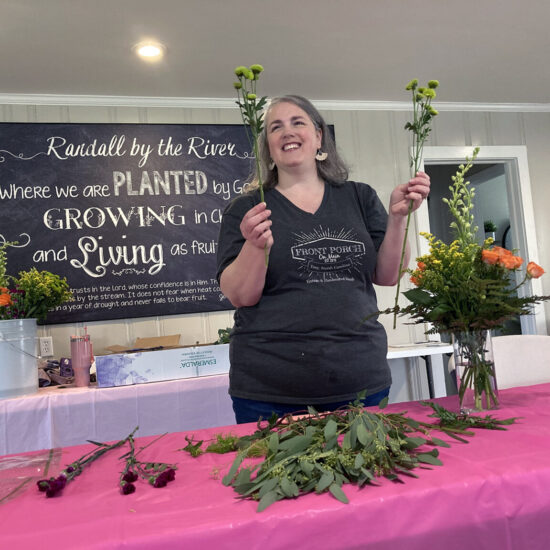

Casa Verde Commons, which opened in Colorado Springs in 2002, is home to 67 adults, 15 young people, 12 dogs, 8 cats, and one lawnmower. Courtesy photo
COLORADO SPRINGS, Colo. (RNS) — Casa Verde Commons is home to 67 adults, 15 young people, 12 cats, eight dogs, and one lawn mower.
It’s not exactly heaven on earth.
But it’s close.
“Co-housing is better than what we knew,” said Michelle Rodriguez, who moved to Casa Verde with her husband and son in January. “This scratched our itch for intentional community and downsizing, plus our son has a bunch of extended grandparents.”
“E pluribus unum” — the words on the Great Seal of the United States — means “out of many, one.” But Americans aren’t feeling much oneness these days, and many tell pollsters they suffer loneliness, social isolation and little connection with others.
Residents of places like Casa Verde, one of America’s 165 established co-housing communities, hope to change that. They’re planning to open their doors and welcome guests on April 27 during Cohousing Open House Day.
Co-housing communities aren’t communes. Residents own their own homes and a share of community spaces, and they pay monthly homeowner association fees to cover community expenses. Co-housing residences typically cost less to buy and operate than single-family homes built on individual lots, and overall they hold their value.
And they’re not sects or insular religious communities. There are no charismatic leaders, religious creeds or barriers to the outside world. People live together freely because they want to.
About 15,000 people currently live in co-housing communities. And more plan to join them. Another 140 co-housing communities are in the process of getting started, according to cohousing.org.

Jane McKendry tie dyes shirts with granddaughter. McKendry has lived at Muir Commons since it opened in 1991 in Davis, Calif. Courtesy photo
This co-housing model began in Copenhagen, Denmark, in 1970. The model migrated to the U.S. with the 1991 opening of Muir Commons in Davis, Calif. Jane McKendry was one of the founding residents. Twenty-seven years later she’s thankful for life in a community.
“We weren’t particularly thinking about being pioneers,” said McKendry. “Some of us grew up with a sense of community in our families or towns, and we wanted to recapture that. Some didn’t grow up with that sense of community and wanted to gain what they had missed.”
Co-housing communities are often religiously diverse.
The 58 adults and 21 kids who live at Muir Commons include Unitarians, Jews, yoga instructors, meditators, religious “nones” and members of Davis Community Church, a historic Presbyterian congregation. At Casa Verde Commons in Colorado Springs, Colo., the 82 residents between ages of 2 and 92 include Unitarians, Episcopalians, Jews, Buddhists, Religious Scientists and “nones.”
Up the road in Boulder, Colo., there are more Buddhists at the Wild Sage co-housing community. Karin Hoskin has lived there with her husband, two teenage kids, mother-in-law, two cats and two dogs since it opened in 2004.
Hoskin is also executive director of the Boulder-based Cohousing Association of the United States, which will hold its annual convention May 30-June 2 in Portland, Ore.
She said co-housing fills a need for community.
“People aren’t staying where they grew up anymore,” said Hoskin. “Seniors don’t have their siblings or their kids around them because they’ve gone away to university or moved out of state for a job. Living in a community can help people feel connected.”
As boomers hit retirement age, there’s a growing interest in elderly co-housing as a warmer and cheaper alternative to retirement homes. Residents also say the communities are safe and accepting places for kids to grow up.
Temescal Commons in Oakland, Calif., was founded as a Christian co-housing community in 2000 but is now interfaith. The community’s common meals on Thursdays and Sundays open and close with prayers or spiritual readings.

Residents of Muir Commons, America’s first cohousing community, gathered for their annual photo in Fall 2018 in Davis, Calif. The sign celebrates the community’s recent installation of 26 electric vehicle charging stations. Founding member Jane McKendry holds the “H.” Courtesy photo
Co-housing communities aren’t perfect. Whenever people live together, disagreements are sure to happen. Typical disputes arise over noisy kids, barking dogs or overgrown hedges. The difference is, residents commit to seeking consensus and settling disputes face-to-face. Most say the hard work is worth it. Those who don’t typically move out.
“There have been a few problems,” said McKendry of Muir Commons. “In one case we had to bring in an outside mediator. We are a community of people who really respect and appreciate each other, and we basically see conflict as a growth opportunity.”
Each community sets its own rules and policies, but most offer weekly meals in a “common house” as well as other gatherings and work days throughout the year. Most communities are built using “green” construction methods to reduce energy consumption.
Chores and community events are handled by committees that take care of tasks from finance to fun. A marketing committee typically handles inquiries from homebuyers wanting to buy in.
While living in community has its challenges, residents like Heather Powell Browne say the benefits far outweigh any downside.
Powell Browne, who works at Colorado College, moved to Casa Verde with her then-5-year-old son a decade ago.
Not long after they moved in, her son told her he needed 20 dirty pennies for a first-grade science project the next morning. So Boone turned to their neighbors for help.
“I put an empty bowl on the front porch and sent out an email,” said Powell Browne. “The next morning, it was like leprechauns had filled the bowl!”

